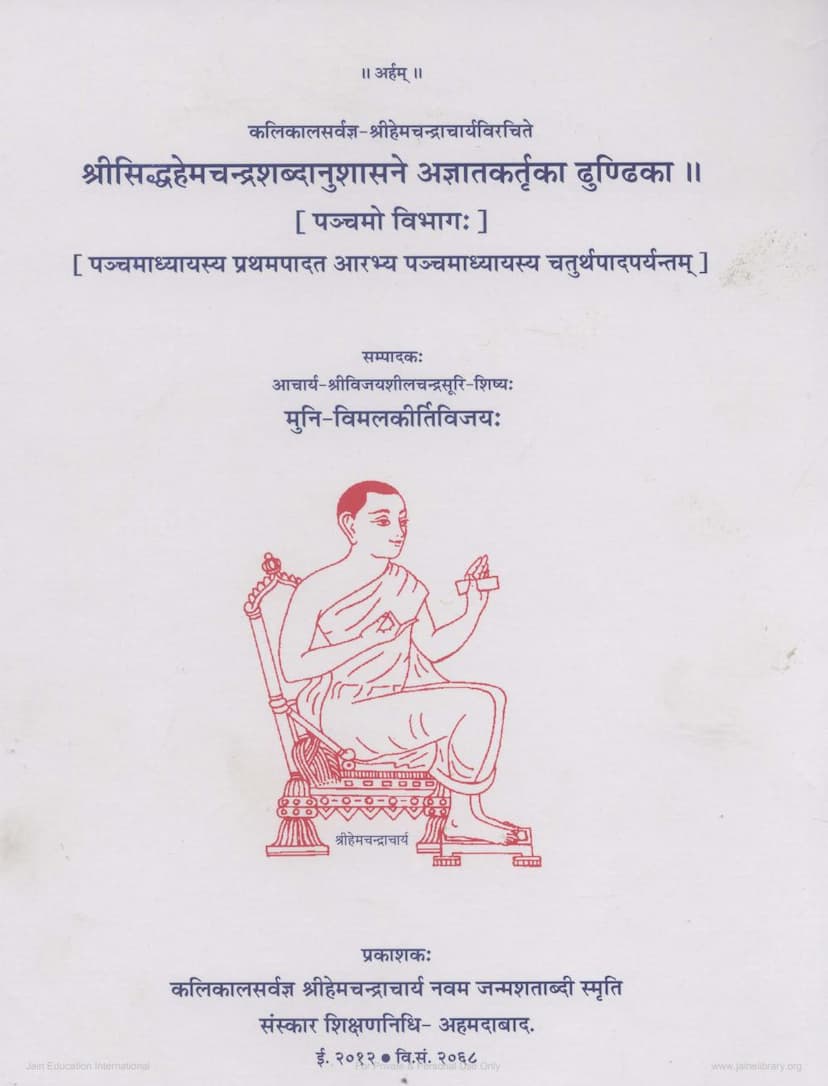Siddha Hemchandra Shabdanushasane Agyat Kartuka Dhundika Part 05
Added to library: September 2, 2025

Summary
This is a comprehensive summary of the provided Jain text, focusing on the content and structure of the first chapter (or the first part of the fifth chapter) of the Siddha Hemchandra Shabdanushasan, specifically the "Agyat Kartuka Dhundika" commentary.
Book Title: Siddha Hemchandra Shabdanushasane Agyat Kartuka Dhundika Part 05 Author: Vimalkirtivijay Publisher: Kalikal Sarvagya Shri Hemchandracharya Navam Janmashatabdi Smruti Sanskar Shikshannidhi Ahmedabad Publication Year: 2012 CE / 2068 VS
Summary:
This volume, "Agyat Kartuka Dhundika Part 05," is a commentary on the fifth chapter of Acharya Hemachandra's renowned Sanskrit grammar, the Siddha Hemachandra Shabdanushasanam. This specific part covers the first to the fourth pāda (sections) of the fifth chapter. The commentary is edited by Muni Vimalkirtivijay, a disciple of Acharya Shri Vijayilchandra Suri. The publication is by the "Kalikal Sarvagya Shri Hemchandracharya Navam Janmashatabdi Smruti Sanskar Shikshannidhi" in Ahmedabad, reflecting a commemoration of the 9th birth centenary of Acharya Hemachandracharya.
The fifth chapter of the Siddha Hemachandra Shabdanushasanam primarily deals with the Kṛt (कृत्) and Taddhita (तद्धित) suffixes in Sanskrit grammar, which are crucial for forming nouns and adjectives from verb roots. The "Dhundika" commentary aims to explain these suffixes in detail, providing numerous examples and grammatical analyses.
This particular volume (Part 05) focuses on the Kṛt (कृत्) section, specifically covering the formation of words derived from verb roots that function as nouns or adjectives. The commentary meticulously explains the application of various kṛt suffixes according to the sutras (grammatical rules) laid down by Acharya Hemachandra.
Key aspects covered in this volume include:
- Kṛt Suffixes: The volume delves into a wide array of kṛt suffixes, detailing their formation, usage, and providing illustrative examples. This includes suffixes like -
- -त (kta): Used to form past passive participles.
- -त्वा (-ktva): Used to form absolute participles.
- -नीय (anīya), -तव्य (tavya): Indicating obligation or fitness.
- -य (ya), -कप् (kyap), -णक् (ṇak), -तृच् (tṛc), -अच् (ac), -अन (an), -इन् (in), -क (-a): These suffixes are extensively explained with their specific grammatical rules and numerous word examples.
- -घ् (gh), -घञ् (ghañ): Suffixes used to form abstract nouns denoting the action or the agent.
- -अ (a): A common suffix used to form nouns and adjectives.
- -इष्णु (iṣṇu), -खुकञ् (-uk): Suffixes indicating habit or tendency.
- -क (a), -कन् (kan), -श (a), -ण (-a), -अक (aka), -थक् (thak), -अन (an), -अनण् (aṇ): These are various suffixes used to form nouns and adjectives from verb roots, often indicating the agent or instrument.
- Verbal Nouns and Participles: The commentary explains how kṛt suffixes transform verb roots into meaningful nouns and participles, which are essential for constructing sentences and understanding the nuances of Sanskrit vocabulary.
- Specific Sutras and Examples: Each section is organized around specific sutras from the Siddha Hemachandra Shabdanushasanam, followed by detailed explanations and etymological breakdowns of example words. The commentary often clarifies the application of rules, exceptions, and rare usages.
- Grammatical Analysis: The commentary provides a detailed grammatical analysis of each example word, including the root verb, the applied suffix, phonetic changes (like guna, vriddhi, elision, etc.), and compound rules (samasa).
- Commentarial Traditions: The editor, Muni Vimalkirtivijay, acknowledges the guidance of Acharya Vijayashilchandra Suri and the inspiration of Acharya Vijayasuryodayasurishwarji Maharaj, indicating a continuation of the rich Jain scholarly tradition. The editor also expresses gratitude to Muni Kailokyamandanvijayji Maharaj for resolving doubts during the editing process.
Overall Significance:
This volume is a significant contribution to the study of Sanskrit grammar from a Jain perspective. It provides a detailed and scholarly exposition of the kṛt suffixation rules as presented in the magnum opus of Acharya Hemachandracharya. The commentary aims to make the complex rules of Sanskrit grammar accessible to students and scholars, thereby preserving and propagating this vital aspect of Jain literary heritage. The publication serves as a testament to the ongoing efforts of the publishing institution to bring forth and disseminate ancient Jain texts for the benefit of the global scholarly community.